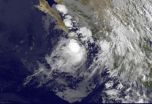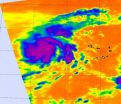(Press-News.org) GAINESVILLE, Fla. — In the complex world of ant-plant partnerships, serial monogamy can help trees maximize their evolutionary fitness, a new University of Florida study shows.
Trees that sequentially partner with multi-species sets of ants produce more offspring than trees that maintain a lifelong association with any single ant — even when those sets include ant species that appear to harm the tree, said Todd Palmer, a UF biology professor.
The study has broad implications because many of the world's ecosystems rely on cooperative partnerships between species, Palmer said.
"When you snorkel on a coral reef, you're hovering over an animal — the coral — that relies heavily on the algae it cooperates with for photosynthesis, just as when you eat an apple, you're reaping the benefits of a tree that was pollinated by an insect," he said.
According to Palmer, many prior studies of cooperation in nature, or mutualism, have focused on the "cheater problem": How can cooperation persist when both sides have an incentive to reap benefits without contributing to the common good? Ecological studies tend to be short-term, with species labeled as "cooperators" or "freeloaders," depending on cost-benefit ratios calculated over just a few years.
Palmer and his team took a different approach, looking at a common African tree and its relationships with four specialized ant partners over the tree's lifetime.
The surprising finding was that the tree in Kenya did best when occupied by all four ant species over its lifetime, even though one ant species joined forces with beetles in ways that increased tree death rates; another sterilized the tree; and a third was so scared of the other three competing ant species that it didn't do much of anything, said Palmer, whose paper is published this week online in Proceedings of the National Academy of Sciences.
"Looking at the costs and benefits to the tree, not just at a single moment, but in terms of number of offspring produced over a lifetime, the best possible outcome is obtained not by having what we thought was the "good mutualist," but rather by having all four ant species at different life stages — even the so-called parasite, cheater, freeloader scumbag ants," he said.
In the past, only one of the four ant species was recognized as a cooperator, because it successfully defended the tree from elephants and other herbivores in exchange for using the tree's resources, Palmer said. The other three ants were thought to exhibit varying degrees of cheating behavior, he said.
The key to the new findings is the timing. When a species lives a long time, its needs may change drastically as it grows from young to old, and sequential associations with several partners may help it meet those needs at different times, he said.
"A human analogy might be that what we look for in romantic partnerships when we're younger — perhaps a daring and exciting person who likes to be bold and take risks — is not necessarily the thing that we are looking for in a romantic partner when we get older, when stability, the ability to hold down a job and provide for children becomes more important," he said. "The best possible partner is really a function of where you are in your life and what your needs are at that particular moment."
In the same way, a mutualistic species may require a partner that helps it survive during its vulnerable younger years, even if that partner prevents it from reproducing, Palmer said. Later in life, when large size makes individuals less vulnerable, the ideal partner may be one that enhances reproduction even as it reduces the chances of longer-term survival, he said.
Over eight years, Palmer and colleagues monitored annual survival, growth, reproduction and ant occupancy of 1,750 Acacia drepanolobium trees and constructed demographic models that related the trees' lifetime fitness to occupation by different combinations of the four ant partners. The ostensible freeloaders turned out to be more than they seemed, he said.
The ant that conspires with a wood-boring beetle that can kill trees? It turns out that before it kills them, it causes them to produce an inordinate number of seeds, Palmer said. Likewise, the ant that castrates the tree is actually an aggressive defender, so while the tree doesn't reproduce for many years, it is likely to survive to produce fruit more down the road after the castrator is evicted by another ant species.
And the ant that appeared to be a do-nothing actually does just enough, Palmer said. "It defends trees a little bit, but unlike the other ant species, it is very faithful and hardly ever abandons the tree," he said. "And having any ant at all is very much better than having no ant, because if you have no ants, you get hammered by everything from caterpillars to elephants."
###
Credits
Writer
Cathy Keen, ckeen@ufl.edu, 352-392-0186
Source
Todd Palmer, tmp@ufl.edu, 352-214-0894
Titan, one of Saturn's moons, is the only moon in the solar system with an atmosphere ― ten times denser than the atmosphere of Earth. Five years ago, the Cassini–Huygens mission to Saturn, a collaboration between the European Space Agency and NASA, sent a probe through Titan's atmosphere, revealing that Titan is home to a landscape that includes hills, valleys and most notably lakes.
A researcher involved with the mission, Prof. Akiva Bar-Nun of Tel Aviv University's Department of Geophysics and Planetary Sciences, has now determined the composition of these lakes. ...
Scientists from the California Institute of Technology and UCLA have discovered evidence of "universal ubiquitous magnetic fields" that have permeated deep space between galaxies since the time of the Big Bang.
Caltech physicist Shin'ichiro Ando and Alexander Kusenko, a professor of physics and astronomy at UCLA, report the discovery in a paper to be published in an upcoming issue of Astrophysical Journal Letters; the research is currently available online.
Ando and Kusenko studied images of the most powerful objects in the universe — supermassive black holes that ...
Grabbing a child firmly by the arm, yelling and repeatedly punishing him or her may not be without long-terms risks, according to researchers from the Université de Montréal. They are studying how this harsh parenting can impair the emotional development of a child, possibly leading to anxiety disorders such as social phobia, separation anxiety and panic attacks.
"Several studies have shown that coercive parenting practices are linked to anxiety," says Françoise Maheu a professor at the Université de Montréal's Department of Psychiatry and lead investigator of the study. ...
PHILADELPHIA (September 21, 2010)—Molecularly targeted therapies can reduce tumors rapidly. However, not all tumors respond to the drugs, and even those that do often develop resistance over time. Looking for a way to combat the problem of resistance, researchers at Fox Chase Cancer Center hypothesized that hitting already weakened cancer cells with a second targeted agent could kill them—but only if it was the right second agent.
One well-validated molecular target for anti-cancer drugs is the epidermal growth factor receptor, or EGFR. Using a novel screening approach, ...
OAK BROOK, Ill. – September 21, 2010 – Researchers from Italy have reported results from more than 10 years of follow-up showing that the placement of multiple endoscopic stents for the treatment of postoperative biliary strictures remains excellent with a low rate of stricture recurrence after this lengthy period of time. When strictures do recur, they can be safely and successfully retreated endoscopically. The study appears in the September issue of GIE: Gastrointestinal Endoscopy, the monthly peer-reviewed scientific journal of the American Society for Gastrointestinal ...
Impulsive behaviour can be improved with training and the improvement is marked by specific brain changes, according to a new Queen's University study.
A research team led by neuroscience PhD student Scott Hayton has pinpointed the area of the brain that controls impulsive behavior and the mechanisms that affect how impulsive behavior is learned. The findings could have a significant impact on the diagnosis and treatment of several disorders and addictions, including ADHD and alcoholism.
"In the classroom, kids often blurt out answers before they raise their hand. ...
Tropical Storm Georgette formed pretty quickly and the GOES-11 satellite captured her clouds extending over extreme southern Baja California and western Mexico today. Georgette formed just south of Cabo San Lucas this morning and is headed for a Baja landfall.
The Geostationary Operational Environmental Satellite or GOES-11 is stationary in its position in space, watching over the weather in the western U.S. GOES-11 captured an infrared image of Tropical Storm Georgette's rounded cloud cover stretching north into Baja California, Mexico at 13:15 UTC 9:15 a.m. EDT today, ...
This Atlantic hurricane season has now spawned 14 tropical depressions and 12 of them have strengthened into tropical storms. The latest is now called Tropical Storm Lisa and is in the Eastern Atlantic Ocean. NASA's Aqua satellite flew over Lisa when she was still a low pressure area, but showed a center of circulation and banding of thunderstorms circling it, indicating the storm was getting organized.
The Atmospheric Infrared Sounder (AIRS) instrument that flies aboard NASA's Aqua satellite captured "Lisa" when she was still a low pressure area yesterday, Sept. 20 at ...
Hurricane Igor may be changing into an extra tropical storm and losing his warm core of energy, but he hasn't lost his punch as hurricane watches are up today in eastern Canada. The GOES-13 satellite captured a look at Hurricane Igor this morning, and noticed the storm continues to grow larger and part of that expansion is likely a result of absorbing Julia's remnants.
The Geostationary Operational Environmental Satellite or GOES-13 is stationary in its position in space, watching over the weather in the eastern U.S. GOES-13 captured a visible satellite image of Hurricane ...
An inexpensive, hundred-year-old therapy for pain – aspirin – is effective in high doses for the treatment of severe headache and migraine caused by drug withdrawal, according to a new study by researchers with the UCSF Headache Center. Study participants were administered aspirin through an IV and 25 percent of the time they reported a significant reduction in pain – three points on the 10-point pain scale. (A difference of three points downgrades a headache from severe to moderate, moderate to mild, or from mild to pain-free). Participants reported a more modest pain ...


